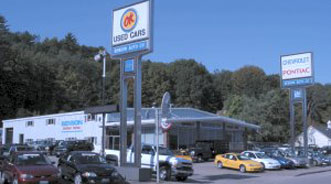GM & Dealers Celebrate Chevrolet’s 100 Years

After being awarded the Chevrolet franchise in 1915, brothers Harold Benson and Ray Benson and their cousin Roy Benson drove nearly 300 miles from New York City to a tiny New Hampshire town in their first Chevrolet.
Nearly 100 years later, and as one of the oldest Chevy dealerships in the United States, Benson Auto in Franklin, N.H., is still selling Chevrolets to loyal customers from their original North Main Street location.
“My grandfather and father instilled in me that if you put the customer first, and are honest with them, they’ll come back to you,” stated Corey Benson, fourth-generation president of Benson Auto.
“We are proud to be a Chevy dealer and owe much of our success to the many generations of customers that continue to do business with us,” Benson continued.
General Motors acknowledged Chevrolet’s retail sales force has evolved significantly from ordering a Chevrolet from the catalog at the local gas station to today’s network of approximately 3,000 dealerships in 50 states.
Shortly after the first Chevrolet was built in a rented garage near downtown Detroit in 1911, co-founder William Durant recognized the need to establish a distribution system to sell vehicles.
Building off his plan to sell Buicks, OEM officials recapped that Durant’s Chevy dealer network began as a collection of buggy and bicycle shops, one-stall garages, feed stores and various other turn-of- the-century entrepreneurs looking to take a chance on the emerging automobile culture spreading throughout the country.
One of these was Hare Chevrolet that started off building wagons in Noblesville, Ind., before the Civil War and qualified for a Chevy franchise in 1921.
As the oldest transportation company in America, GM pointed out Hare Chevrolet is run by sixth-generation sisters, Courtney Cole and Monica Peck, and is a Noblesville institution.
“When my great, great, great grandfather started selling automobiles, he kept the horse-and-buggy business because he was unsure the automobile would be a sustainable form of transportation,” stated Peck, co-owner of Hare Chevrolet.
“We are now in our fourth dealership location, and are thrilled to be part of the Chevy history, though we know that it is the people and rich history that have helped our success,” she continued.
Over the years, the automaker insists local Chevy dealers have become social institutions and community leaders. They sponsor local youth sporting leagues, including the Chevy Youth Baseball and Chevy Youth Soccer initiatives; local charities; and conduct child safety clinics. Dealer principals and personnel lead Kiwanis Clubs and host car enthusiasts meetings.
GM believes such engagement has helped secure purchase loyalty of generations of families in their hometowns.
“Giving back to the community is just a core value of Hare’s business,” said Peck of Hare Chevrolet.
The company thinks she’s not alone.
To unify the dealer image, Chevrolet in the 1990s started uniform dealership image programs with the goal of making stores across the United States recognizable to customers with a modern appearance to draw in new customers.
As part of Chevrolet’s most-recent facility image program, brand officials expect 80 percent of the dealer network to complete changes by the end of 2014.
In addition, Chevrolet is harnessing the power of the sun to install solar-powered electric charging stations for its Volt electric cars at dealerships in North America.
Officials estimate the Green Zone initiative will generate electricity equivalent to 12 full vehicle charges per day with excess electricity created helping supplement the dealership’s power needs.
Serra Automotive in Grand Blanc, Mich., was one of the first dealerships to install a solar canopy. Serra Automotive president Joe Serra sees it as competitive advantage.
“The question isn’t whether to install a solar canopy, it’s where and how many,” Serra projected.
“It’s a win for us because the electricity generated will help reduce operating costs, and it’s a win for the environment since solar power helps reduce our carbon footprint,” he continued.
With the explosion of the Internet in the 1990s and 2000s, more and more customers arrive at dealerships armed with all the information needed to make an informed vehicle purchase with a click of a mouse.
GM stressed Chevy dealers realized early on the value of establishing an online presence. Today, the automaker emphasized Chevy rooftops engage consumers through Twitter, Facebook and online chats.
Jim Ferman, a fifth-generation owner of Ferman Chevrolet in Tampa, Fla., that qualified for a Chevy franchise in 1921, said customer service remains important regardless of the technology explosion.
“I was taught the golden rule, that if you take care of your customer, they’ll take care of you,” Ferman declared.
“We earn our customer’s loyalty everyday and have never forgotten that,” he added.
Throughout history, GM maintained that Chevrolet dealers have survived economic downturns, the Great Depression and many recessions.
“While it is difficult to identify the oldest Chevrolet dealer in the United States, we think it is wonderful to have so many long term dealerships that have been part of our journey,” commented Alan Batey, Chevrolet vice president of sales and service.
“The key for our future is to pay attention to the details and do the basics brilliantly for every customer, every time,” Batey continued.
Chevy Ramps up Festivities to Mark 100 Years
In celebration of its 100th birthday today, Chevrolet is recognizing the people who have made the brand successful. Brand officials are offering dealer promotions in hometowns across the United States, starring in a feature-length documentary and inviting fans to share their Chevrolet memories online.
The activities cap a year-long celebration of Chevrolet’s Centennial that kicked off in January at the North American International Auto Show in Detroit and encompassed events in Chevrolet hometowns around the world.
“We understand Chevrolet is more than a brand — it belongs to everyone who owns, designs, builds, sells or loves Chevrolets,” stressed Chris Perry, vice president of Chevrolet global marketing and strategy.
“The past 100 years wouldn’t have been possible without millions of people who have each made Chevrolet a part of their life’s journey,” Perry continued.
To thank U.S. customers, Chevrolet dealers across the nation will sponsor open houses and a number of promotions through Monday. Chevrolet customers can visit the Chevrolet website to learn more about centennial celebrations in their area.
The passion many feel for Chevrolet is the subject of a new Chevrolet Centennial documentary produced by award-winning filmmaker Roger Sherman. “Chevy 100, An American Story” explores Chevrolet culture through owners, collectors, journalists and historians.
Following a Detroit premiere today at the Detroit Institute of Arts; the film will air nationally Nov. 21 at 8 p.m. on the Velocity Channel and will then be available on DVD from chevymall.com.
Because it’s a global brand, Chevrolet is also celebrating its centennial around the world.
For example, Chevrolet Europe is recognizing Louis Chevrolet’s Swiss birthplace of La Chaux-de-Fonds by commissioning a public artwork on the Parc de l’Ouest.
In Korea, Chevrolet customers set a Guinness World Record by creating the world’s largest car logo.
Chevrolet in August hosted a Chevrolet parade at the Woodward Dream Cruise where more than 100 old and new Chevrolets — 50 of them Chevrolet Volts — cruised Woodward Avenue.
Furthermore, Chevy also served as presenting sponsor for the Cruise, which brings more than 50,000 vehicles and 1.5 million fans to Detroit’s storied Woodward Avenue each year.
Also, Chevrolet joined with the Indianapolis 500 to celebrate 100 years of shared history and announced that it is returning to Indy car racing as an engine supplier and as sponsor of the Detroit Grand Prix.
To connect with fans globally, Chevrolet launched its interactive Chevy100.com website earlier this year. The brand also recently added two interactive Web experiences: “The Road We’re On” and “The Ride of Your Life.”
In addition, Chevrolet asked its fans on Twitter to post questions that Alan Batey, vice president of Chevrolet sales, service and marketing, will answer today on the Chevrolet YouTube page.
GM noted that upcoming introductions include the Chevrolet Volt extended-range electric vehicle in Europe and China as well as the Chevrolet Spark in the United States and Canada in 2012 and its electric sibling in select global markets in 2013.
These models are set to join new global introductions such as the 2013 Chevrolet Malibu sedan and new Chevrolet Colorado midsize truck.
KBB Picks Its Favorite Chevrolet Models
To hail the brand, Kelley Blue Book named its Top 10 Chevys of All Time, including the most significant product and design developments in the nameplate’s long and storied 100-year history
“For many of us, Chevrolet is an American icon on a par with baseball and apple pie — a brand deeply engrained in the fabric of our lives,” noted Jack Nerad, KBB’s executive editorial director.
“In determining the ‘Top 10 Chevys of All Time,’ our editorial staff chose the vehicles that offered not only technical innovation, but also changed the automotive landscape. Each one is a watershed car whose influence is still felt today,” Nerad continued.
The following is an abridged version of the editors’ Top 10 Chevrolets of All Time.
—1912 Chevrolet Series C Classic Six: “The first step in establishing one of America’s most iconic brands was introduced in 1911 and went on sale the following year,” KBB said. “The seminal Chevrolet model was priced at a then-hefty $2,150, which put it well out of the reach of blue-collar workers who barely earned that much as their annual wages. The model had only moderate success, but set the tone for what would become a megabrand.”
—1916 Chevrolet 490: “While the first Chevrolet was positioned to the middle of the car-buying market — well-to-do professionals — the 1916 490 was intended to go head-to-head with Ford’s incredibly popular Model T,” editors explained. “It got its name from its base price — $490 — a figure that not coincidentally was $5 less than that of its prime rival, and it sent the brand on its present course.”
—1929 Chevrolet with Stovebolt-Six Engine: “In the wake of Ford’s introduction of the Model A, Chevrolet went its arch-rival two better — two cylinders, that is,” KBB recapped. “Equipped with the legendary ‘stovebolt’ six-cylinder engine, the 1929 Chevrolets offered two more cylinders than Ford’s ‘four-banger’ and established the brand as Ford’s key competitor.”
—1936 Chevrolet Suburban Carryall: “Recognized by most automotive historians as the first-ever sport utility vehicle, the 1936 Chevrolet Suburban Carryall combined a station-wagon body style with a half-ton truck chassis to create a new market segment that’s still going strong after more than 75 years,” editors declared.
—1948 Chevrolet Series 3100 Pickup: “The 1948 Chevrolet Series 3100 Pickup set the stage for Chevy’s modern-day pickups by introducing a new level of unexpected interior creature comforts, like a full three-across adjustable bench seat in place of the old trio of individual fixed-position perches, inside door locks, ‘Four-fold’ ventilation and an accessory AM radio,” KBB highlighted.
—1955 Chevrolet with Turbo-Fire V8: “A double winner for the division, the 1955 Chevrolet line ushered in both the now-iconic 1955-1957 ‘Tri5’ era and the spectacularly successful and incredibly long-lived small-block V-8 engine, which supplemented the veteran inline six,” editors explained. “The introduction of the new Turbo-Fire V8 option helped Chevy sell more than 1.7 million units in this pivotal year.”
—1963 Corvette Sting Ray: “Arguably the greatest and unquestionably one of the most desirable models of all time, the 1963 Chevrolet Corvette Sting Ray was a rolling revelation in style and technology that has influenced the look and feel of every successive generation,” editors surmised.
—1960-1969 Chevrolet Corvair: “Created in response to the increasing threat posed by imports — notably the Volkswagen Beetle — the Chevrolet Corvair also was meant to counter the arrival of new downsized domestics like the Ford Falcon and Plymouth Valiant,” KBB recollected. “Though many car reviewers liked Chevy’s innovative approach to small-car design, Ralph Nader’s devastating Unsafe at Any Speed inflicted a mortal wound to the car’s reputation.”
—1967-69 Chevrolet Camaro: “With the Ford Mustang galloping out of the blocks at a record sales pace, Chevy responded by introducing its own brand of pony car, the now legendary Camaro,” editors noted. “Although it shared some platform mechanicals with the upcoming Chevrolet Nova, the Camaro’s aggressively refined exterior styling set it well apart from its compact kin.”
—2011 Chevrolet Volt: “A genuine revolution in automotive transportation, the 2011 Chevrolet Volt stands as one of the crowning achievements of the division’s century of ongoing progress,” KBB stated. “Coupling knowledge gained from GM’s pioneering EV1 electric car program in the 1990s, engineers on the Volt development team managed to bring this sleek, well-appointed four-passenger liftback sedan from an auto show concept to full production status in less than four years.”
The Chef and His Chevy
A recent post on the Faces of GM blog highlighted Guy Fieri, the host of Food Network’s “Diners, Drive-ins and Dives.”
Officials recapped that Fieri is seen with his 1967 red Chevrolet Camaro in just about every episode.
“That car isn’t just a prop for one of the favorite chefs on TV. During this summer’s Woodward Dream Cruise, we found out that Guy is a real dyed-in-the-wool Chevrolet aficionado,” brand officials discovered.
GM recounted that Fieri had two Camaros with him at the Dream Cruise — a yellow 2011 Camaro SS and the red 1967 Camaro that is often seen on his program.
“Just to make things clear, I have eight more GM cars at home. I didn’t get to bring all my toys and show them,” Fieri said.
Fieri went on to share with AutoTrader.com that his ’67 Camaro started life with a 327 engine, but it now has a 350 with 4-speed transmission.
The TV personality insisted that he’s been a GM guy since he was five or six years old.
“Guy is instantly recognizable and when people see him once, they remember him,” Chevy officials insisted.
“With his spiky hair, tattoos and unstoppable energy, he draws fans from all segments of society,” they continued. “He talked and posed with people of all ages. signing autographs and chatting all the time. And while he was at the Dream Cruise, he never strayed too far from his cars. You get the feeling that a kitchen and his cars are where he feels most comfortable.”
According to his book, Diners, Drive-ins and Dives: An All-American Road Trip . . . with Recipes, Fieri writes in a section titled How I Got My Wheels: “I’m a big Chevy fan. I won’t drive a Ford. I’ll drive a Dodge if I have to.”
GM asked him how he developed this passion for the bowtie brand. Fieri responded, “Chevy’s always led the way. The way it looks, the way it all ties together. Chevy’s always just been the coolest.”
Fieri went on to mention he is even considering a Chevy tattoo.
“We asked him to let us tag along if he does that,” Chevy officials concluded.


